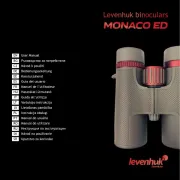Levenhuk Binoculars
User manual
Objective lens
Eyepieces
Focusing/diopter adjustment ring
Compass case
Compass light switch (7x50: not shown)
Battery compartment (8x30: not shown)
Tripod socket cover
Strap mount (7x50: not shown)
A
B
C
D
E
F
G
H
Caution! Never look directly at the Sun through this device, as this may cause permanent eye damage and even blindness.
General information
Marine, reliable and sturdy, Levenhuk Nelson binoculars produce a perfect at image and are a perfect choice for people who like to travel a lot,
especially on the water, and oen nd themselves in extreme situations and harsh conditions, where regular binoculars just would not do. The
rugged shell protects the intricate optical system inside from any sudden impacts or moisture, and withstands poor weather conditions, rain
and sea waves.
Features:
• High-quality Porro prisms made of fully multi-coated BaK-4 optical glass;
• Waterproof shells (IPX7), embossed for the perfect grip;
•Eyecups made of so rubber;
• Individual focusing and diopter adjustment mechanisms;
• Built-in compass with diode light for easy orienting in any light conditions;
•Rangender scale for convenient measuring of the observed object’s size or distance to the object;
•Adaptable to a tripod (purchased separately).
The kit includes: Levenhuk Nelson binoculars, dust caps for eyepieces and objective lenses, strap, pouch and optics cleaning wipe, batteries,
user manual and warranty.
Focusing and diopter adjustment
Your le eye vision might be dierent from that of your right eye and you might need to adjust the diopter settings and focus the image. The
focusing is individual, which is typical for marine binoculars. Each optical tube is focused independently.
Follow this procedure to adjust focus and diopter setting:
•Set right and le eyepiece to zero.
•Look through the binoculars at an object about 100 meters away.
•Close your right eye and rotate the le focusing wheel until the view is focused in the le eyepiece; then, do similarly for the le eye and
right eyepiece.
The binoculars are now adjusted to your eyesight. Note the diopter adjustment for further reference.
Interpupillary distance adjustment
Look through the binoculars’ eyepieces with both eyes. To adjust the interpupillary distance, keep varying the angle between the binoculars’
parts (relative to its central axis) until the image merges into a single circle. Remember the setting for future use.
Levenhuk Nelson 8x30 Levenhuk Nelson 7x50
EN




















